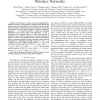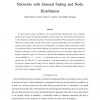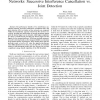888 search results - page 24 / 178 » Capacity of Arbitrary Wireless Networks |
INFOCOM
2009
IEEE
14 years 2 months ago
2009
IEEE
—In this paper, we focus on the networking-theoretic multicast capacity for both random extended networks (REN) and random dense networks (RDN) under Gaussian Channel model, when...
CORR
2010
Springer
13 years 7 months ago
2010
Springer
In many wireless systems, interference is the main performance-limiting factor, and is primarily dictated by the locations of concurrent transmitters. In many earlier works, the l...
INFOCOM
2007
IEEE
14 years 2 months ago
2007
IEEE
— By posing the problem of bandwidth allocation as a constrained maximization problem, it is possible to study various features of optimal bandwidth allocation, and hence the cap...
INFOCOM
2003
IEEE
14 years 29 days ago
2003
IEEE
Abstract— Network throughput and packet delay are two important parameters in the design and the evaluation of routing protocols for ad-hoc networks. While mobility has been show...
ICC
2009
IEEE
14 years 2 months ago
2009
IEEE
Abstract—The performance benefits of two interference cancellation methods, successive interference cancellation (SIC) and joint detection (JD), in wireless ad hoc networks are ...



